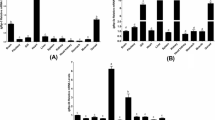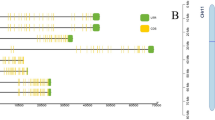Abstract
The 14-3-3 epsilon (14-3-3ε) is a member of the 14-3-3-protein family claimed to play important roles in many biological processes. In this study, two alternative 14-3-3 epsilon mRNAs, designated as 14-3-3EL and 14-3-3ES were identified from the shrimp L. vannamei. The 14-3-3EL isoform contains an insertion of 48 nucleotides by intron retention in the pre-mRNA of 14-3-3ε. While the 14-3-3ES occurred after being fully spliced. Using the yeast two hybrid method, the pattern of dimer formation by the two alternative 14-3-3ε isoforms revealed that the shrimp 14-3-3ε formed both homodimers and heterodimers. Both 14-3-3ε transcript variants were constitutively expressed in all shrimp tissues tested but the level of the 14-3-3ES isoform was always lower. However, after white spot syndrome virus (WSSV) infection, the expression level of the two transcript variants changed. At 48 h after infection, expression of 14-3-3EL mRNA increased significantly in the gill and muscle tissue whereas the expression 14-3-3ES increased only in muscle. It was of interest that in the lymphoid organ, there was a significant down-expression of both transcript variants. From these results we suggest that 14-3-3EL and 14-3-3ES might be related to different cellular processes that are modulated during virus infection.




Similar content being viewed by others
References
Fu H, Subramanian RR, Masters SC (2000) 14-3-3 proteins: structure, function, and regulation. Annu Rev Pharmacol Toxicol 40:617–647. doi:10.1146/annurev.pharmtox.40.1.617
van Hemert MJ, Steensma HY, van Heusden GP (2001) 14-3-3 proteins: key regulators of cell division, signalling and apoptosis. Bioessays 23(10):936–946. doi:10.1002/bies.1134
Acevedo SF, Tsigkari KK, Grammenoudi S, Skoulakis EM (2007) In vivo functional specificity and homeostasis of Drosophila 14-3-3 proteins. Genetics 177(1):239–253. doi:10.1534/genetics.107.072280
Wanna W, Rexroad CE III, Yao J (2010) Identification of a functional splice variant of 14-3-3E1 in rainbow trout. Mar Biotechnol (NY) 12(1):70–80. doi:10.1007/s10126-009-9201-6
Sehnke PC, Rosenquist M, Alsterfjord M, DeLille J, Sommarin M, Larsson C, Ferl RJ (2002) Evolution and isoform specificity of plant 14-3-3 proteins. Plant Mol Biol 50(6):1011–1018
Han D, Ye G, Liu T, Chen C, Yang X, Wan B, Pan Y, Yu L (2010) Functional identification of a novel 14-3-3 epsilon splicing variant suggests dimerization is not necessary for 14-3-3 epsilon to inhibit UV-induced apoptosis. Biochem Biophys Res Commun 396(2):401–406. doi:10.1016/j.bbrc.2010.04.104
Ohman T, Lietzen N, Valimaki E, Melchjorsen J, Matikainen S, Nyman TA (2010) Cytosolic RNA recognition pathway activates 14-3-3 protein mediated signaling and caspase-dependent disruption of cytokeratin network in human keratinocytes. J Proteome Res 9(3):1549–1564. doi:10.1021/pr901040u
Wang HC, Leu JH, Kou GH, Wang AH, Lo CF (2007) Protein expression profiling of the shrimp cellular response to white spot syndrome virus infection. Dev Comp Immunol 31(7):672–686. doi:10.1016/j.dci.2006.11.001
Wongpanya R, Aoki T, Hirono I, Yasuike M, Tassanakajon A (2007) Analysis of gene expression in haemocytes of shrimp Penaeus monodon challenged with white spot syndrome virus by cDNA microarray. ScienceAsia 33:165–174
Lo CF, Ho CH, Peng SE, Chen CH, Wang CH, Kou GH (1996) White spot syndrome baculovirus (WSBV) detected in cultured and captured shrimp, crabs and arthopods. Dis Aquat Organ 27:215–225
Galante PA, Sakabe NJ, Kirschbaum-Slager N, de Souza SJ (2004) Detection and evaluation of intron retention events in the human transcriptome. RNA 10(5):757–765
Gontijo AM, Miguela V, Whiting MF, Woodruff RC, Dominguez M (2011) Intron retention in the Drosophila melanogaster Rieske iron sulphur protein gene generated a new protein. Nat Commun 2:323. doi:10.1038/ncomms1328
Ner-Gaon H, Halachmi R, Savaldi-Goldstein S, Rubin E, Ophir R, Fluhr R (2004) Intron retention is a major phenomenon in alternative splicing in Arabidopsis. Plant J 39(6):877–885. doi:10.1111/j.1365-313X.2004.02172
Stamm S, Ben-Ari S, Rafalska I, Tang Y, Zhang Z, Toiber D, Thanaraj TA, Soreq H (2005) Function of alternative splicing. Gene 344:1–20. doi:10.1016/j.gene.2004.10.022
Chaudhri M, Scarabel M, Aitken A (2003) Mammalian and yeast 14-3-3 isoforms form distinct patterns of dimers in vivo. Biochem Biophys Res Commun 300(3):679–685
Aoki H, Hayashi J, Moriyama M, Arakawa Y, Hino O (2000) Hepatitis C virus core protein interacts with 14-3-3 protein and activates the kinase Raf-1. J Virol 74(4):1736–1741
Han SI, Kawano MA, Ishizu K, Watanabe H, Hasegawa M, Kanesashi SN, Kim YS, Nakanishi A, Kataoka K, Handa H (2004) Rep68 protein of adeno-associated virus type 2 interacts with 14-3-3 proteins depending on phosphorylation at serine 535. Virology 320(1):144–155. doi:10.1016/j.virol.2003.11.024
Brockhaus K, Plaza S, Pintel DJ, Rommelaere J, Salome N (1996) Nonstructural proteins NS2 of minute virus of mice associate in vivo with 14-3-3 protein family members. J Virol 70(11):7527–7534
Pei Z, Harrison MS, Schmitt AP (2011) Parainfluenza virus 5 m protein interaction with host protein 14-3-3 negatively affects virus particle formation. J Virol 85(5):2050–2059. doi:10.1128/JVI.02111-10
Wu J, Lin Q, Lim TK, Liu T, Hew CL (2007) White spot syndrome virus proteins and differentially expressed host proteins identified in shrimp epithelium by shotgun proteomics and cleavable isotope-coded affinity tag. J Virol 81(21):11681–11689. doi:10.1128/JVI.01006-07
Won J, Kim DY, La M, Kim D, Meadows GG, Joe CO (2003) Cleavage of 14-3-3 protein by caspase-3 facilitates bad interaction with Bcl-x(L) during apoptosis. J Biol Chem 278(21):19347–19351. doi:10.1074/jbc.M213098200
Acknowledgments
This work was supported by grants from The Thailand Research Fund (TRF) and The Commission on Higher Education (CHE) to Ms. Warapond Wanna (RMU5480007) and the Thailand Government Research Fund (RA1-2551-010 and RA-2553-02-010) from Faculty of Sciences, Prince of Songkla University. We thank Dr. Brian Hodgson for checking the manuscript and valuable comments.
Author information
Authors and Affiliations
Corresponding author
Rights and permissions
About this article
Cite this article
Wanna, W., Thipwong, J., Mahakaew, W. et al. Identification and expression analysis of two splice variants of the 14-3-3 epsilon from Litopenaeus Vannamei during WSSV infections. Mol Biol Rep 39, 5487–5493 (2012). https://doi.org/10.1007/s11033-011-1351-8
Received:
Accepted:
Published:
Issue Date:
DOI: https://doi.org/10.1007/s11033-011-1351-8




